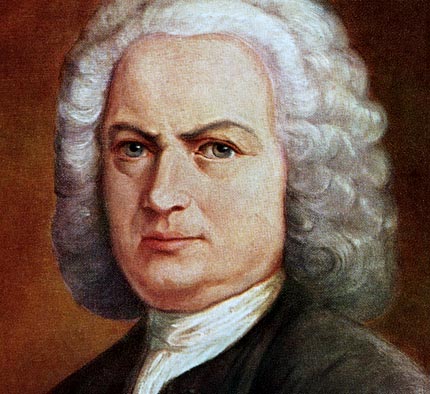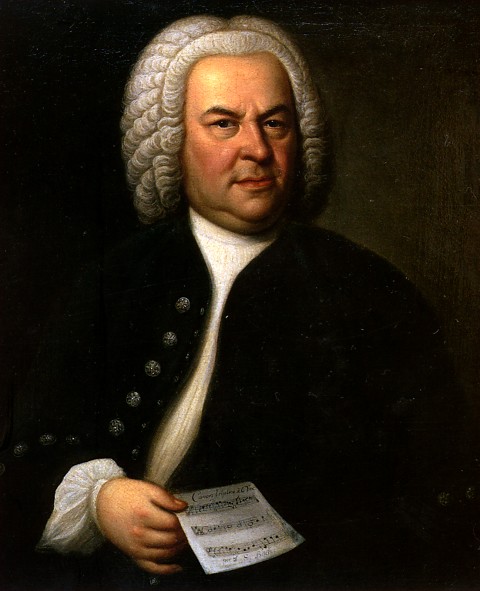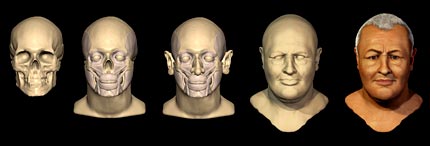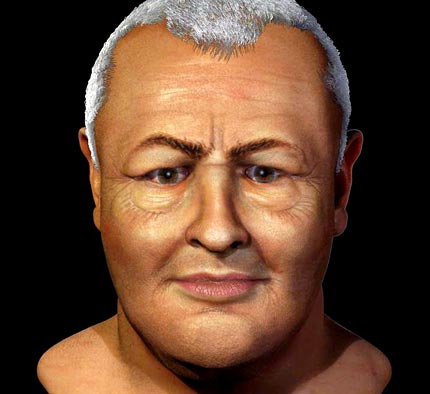Here you’ll see a recent reconstruction of JS Bach’s face from his original bones – and you’ll see that it varies from the popular image we have of what Bach looked like.
BUT, before we get there – I’d like to point out how the mainstream article did a little “naughty” for a more dramatic story. The Reuters articles starts with the JS Bach portrait of the younger Bach that you see above, and exclaims how very different the actual reconstruction looks. Maybe they should have posted a picture of Aunt Bea from the Andy Griffith show, and said “Amazing, look how different it looks.”
Now, the reconstruction DOES look different from what you’d expect. But not so much as when they greased the pan with the photo above.
HERE is a widely accepted authentic portrait of an older JS Bach:
(In not-so-dramatic fashion, you may find the portrait and modern reconstruction are actually strikingly similiar.)
Now let’s look at the graduated reconstruction of JS Bach’s face from his unearthed skull:
And Viola! A closeup of the finished reconstruction. They omitted the wig which also features the difference in look.
“We know he was a physical man, that he danced, that he stamped his feet when he played, that he sang. He was a very dynamic man — with this reconstruction you can see it.”
Bach’s bones were excavated in 1894 and sculptors first used them to help create a bust in 1908.
Are you a JS Bach Fan? Checkout my “Christmas Gloria” where I retrace Bach’s steps in composing for the church service.




I find it bizarre Wilkinson decided to give her reconstruction brown skin and eyes and black eyebrows. Portraits indicate Bach was fair to medium in complexion, with brown or blond eyebrows, and predominantly blue eyes.
Nice article there! Members can visit another article on this at:
http://racehist.blogspot.com/2008/03/bach-swarthoid.html
Most Germanics of old, like most Europeans had dark features as even Benjamin Franklin noted in his “Observations Concerning the Increase of Mankind, Peopling of Countries, etc.” – which can be found on the internet. The increase of blondism in modern Germany is due to more recent migrations from the North and East. All you have to do is look at portraits of old European Royalty to see they were almost always dark. Germanic poets also wrote poems about black hair being a sign of nobility. Also, what people fail to realize is that one of the genes that contributes to light skin is actually Asian. Consequently, Northern and Eastern Europe have high Asian admixture these days.
Hey Dr. Brennan,
Thanks for letting me know about that. That’s pretty fascinating stuff and I plan on finding out more about the skin tones and migration.
I don’t understand how asians, with black hair, black eyes, and usually dark skin could influence light features in other races.
I don’t know either – a recessive gene?
Paintings show that he had light skin and blue eyes. Make all the hypothetical excuses you want. These things are often done with an agenda.
Dr. Brennan is talking nonsense.
Agenda huh?! look at the eyebrows and eyes of the picture you see in this very page. Are eyebrows blond and eyes blue?! I think if we find full DNA from an extremely old skull we ARE indeed able to say what colour of skin or eye the person had. I can sure look at the painting and say eyes are not blue. Call it hypothetical if you like.
@Chris
The paintings were done with an agenda as well. Paintings from that era are not generally considered to be perfectly representative of a person. Being perfectly representative was not even an aesthetic value at that time.
My ancestors are from the South of Germany, and my family has swarthy complexions. Pope Benedict complexion is very similar to that of my family, and he is from Southern Germany. So much for the blonde Aryan stereotype more accorded to myth.